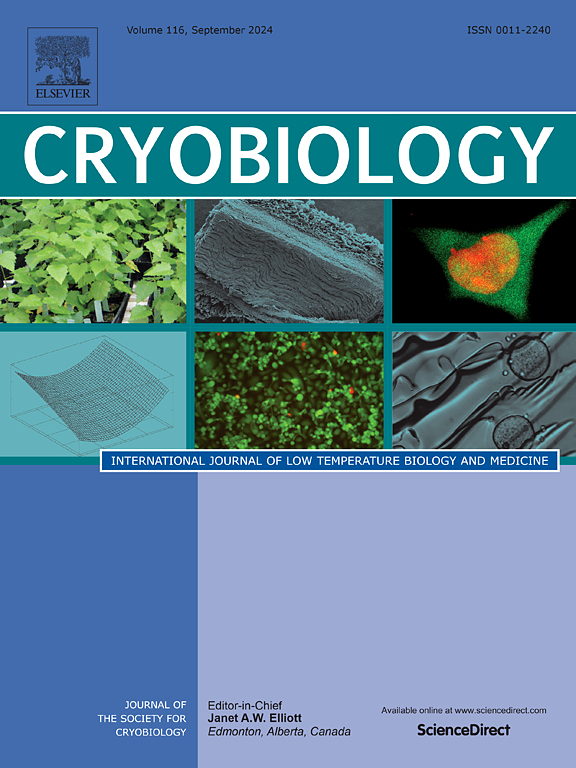Ice ball size and temperature change during cryoablation in a lard and an ethiodized-oil tissue phantom
IF 2.1
3区 生物学
Q2 BIOLOGY
引用次数: 0
Abstract
This in vitro study evaluates the effects of varying concentrations of lard and ethiodized-oil (Lipiodol) on temperature changes and ice ball diameters during cryotherapy. A phantom was constructed using six glass bottles, one filled with 0.9 % normal saline (NS) and the others containing agar phantoms mixed with different proportions of lard and NS (0 %, 10 %, 40 %, 70 %, and 100 % lard). Similarly, a phantom was prepared with ethiodized-oil. Six cryoprobes were inserted into the bottles, and freezing was initiated simultaneously, with temperature readings recorded every 10 s over a 9-min freezing period. CT scans were performed before freezing and at 3, 6, and 9 min post-freezing to measure ice ball diameters, with each phantom undergoing a single freezing cycle. Phantoms with lard or ethiodized-oil showed increased freezing rates with higher concentrations, stabilizing at approximately −140 to −150 °C. The largest ice ball diameters were observed in the 0 % and 10 % lard and ethiodized-oil phantoms. Negative correlations were identified between ice ball diameter and lard concentration at 3, 6, and 9 min (R2 = 0.910, 0.838, 0.778; p = 0.008, 0.019, 0.030), as well as between ice ball diameter and ethiodized-oil concentration at 6 min (R2 = 0.881; p = 0.040). These results suggest that distinct concentrations of lard and ethiodized-oil significantly influence the temporal temperature changes and ice ball dimensions during cryotherapy.

冰球大小和温度变化在冷冻消融期间在猪油和乙烷化油组织幻影
这项体外研究评估了不同浓度的猪油和硫代油(脂醇)在冷冻治疗期间对温度变化和冰球直径的影响。用6个玻璃瓶制作假体,一个装0.9%生理盐水(NS),另一个装不同比例猪油和NS(0%、10%、40%、70%和100%猪油)混合的琼脂假体。同样,用硫化油制备了一个幻影。将6个冷冻探针插入瓶中,同时开始冷冻,在9分钟的冷冻期间每10秒记录一次温度读数。分别在冷冻前、冷冻后3分钟、6分钟和9分钟进行CT扫描,测量冰球直径,每个假体进行一次冷冻循环。含有猪油或硫化油的幻影随着浓度的增加,冷冻速率增加,在- 140至- 150°C左右稳定。在0%和10%猪油和硫化油的模型中,观察到最大的冰球直径。3、6、9 min时,冰球直径与猪油浓度呈负相关(R2 = 0.910、0.838、0.778;p = 0.008, 0.019, 0.030),以及6 min时,冰球直径与硫化油浓度之间的关系(R2 = 0.881;p = 0.040)。这些结果表明,不同浓度的猪油和硫代油显著影响冷冻过程中的时间温度变化和冰球尺寸。
本文章由计算机程序翻译,如有差异,请以英文原文为准。
求助全文
约1分钟内获得全文
求助全文
来源期刊

Cryobiology
生物-生理学
CiteScore
5.40
自引率
7.40%
发文量
71
审稿时长
56 days
期刊介绍:
Cryobiology: International Journal of Low Temperature Biology and Medicine publishes research articles on all aspects of low temperature biology and medicine.
Research Areas include:
• Cryoprotective additives and their pharmacological actions
• Cryosurgery
• Freeze-drying
• Freezing
• Frost hardiness in plants
• Hibernation
• Hypothermia
• Medical applications of reduced temperature
• Perfusion of organs
• All pertinent methodologies
Cryobiology is the official journal of the Society for Cryobiology.
 求助内容:
求助内容: 应助结果提醒方式:
应助结果提醒方式:


